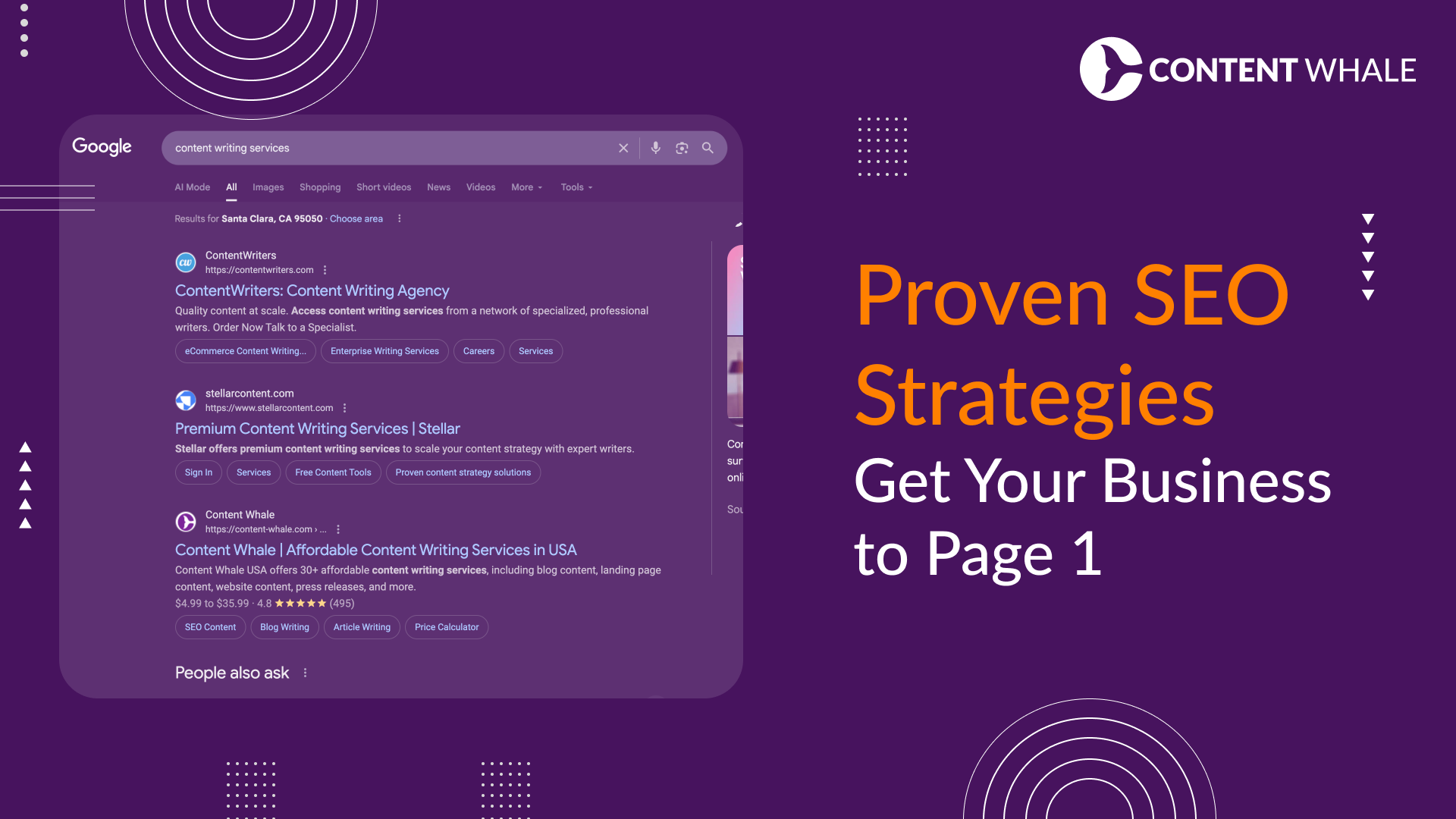
Getting the number 1 rank on Google is crucial for the growth of your business. Ranking first on Google captures about 40% of clicks, while the second and third spots drop to roughly 19% and 10%, making the top spot the biggest traffic driver (Source). If your website appears past the first page, you can miss out on the majority of clicks and qualified leads.
That’s why learning SEO strategies for business has become a must for growth-focused owners and marketers. Modern search engines reward relevance, site performance, and clear value. You can’t just stuff keywords and expect results. Instead, you need a plan that covers keyword research, content structure, on-page SEO best practices, and technical improvements that make it easy for search engines to crawl and index your site.
This guide breaks down 10 actionable methods to show you how to rank on page 1 Google. From building topic clusters to boosting site speed and earning quality backlinks, every step is designed to increase visibility, attract the right audience, and generate more sales opportunities for your business.
Strategy 1: Master Keyword Research & Intent Mapping
Before you start writing content or optimizing pages, you need to understand what your audience searches for and why. Strong SEO strategies for business begin with deep keyword research that aligns with user intent.
Understand User Intent
Group your keywords into informational, navigational, and transactional categories. This helps you create the right type of content for each search. For example, “best CRM for small business” is a transactional query, while “what is CRM” is informational. Matching content to intent improves click-through rates and helps you improve search engine ranking faster. Classify queries via AnswerThePublic or AlsoAsked and build intent buckets in Google Sheets.
Use Advanced Keyword Research Tools
Use tools to uncover long-tail queries, competitor keywords, and trending topics. Build a keyword sheet that includes search volume, competition level, and potential value to your business. These insights make your SEO strategies for business more targeted and help you learn exactly how to rank on page 1 Google by focusing on opportunities with lower competition. Use Semrush, Ahrefs, Google Keyword Planner to export volume, CPC, difficulty.
Create a Keyword-to-Page Map
Assign primary and secondary keywords to each page. Avoid duplicate targeting and ensure every page has a unique focus. This mapping strengthens your internal linking strategy and signals topical authority to search engines. Map primary/secondary keywords in Google Sheets and use Screaming Frog for duplicate targeting audit

Strategy 2: On-Page SEO Best Practices for Business Sites
Strong SEO strategies for business require on-page optimization that helps search engines understand your content and improves user experience. When done right, it moves your pages closer to how to rank on page 1 Google for competitive terms.
Structure Content for Clarity
Use clear headings (H1, H2, H3) to organize information logically. Write descriptive meta titles and meta descriptions that include your main keyword. Add descriptive ALT text to images so they contribute to your on-page SEO best practices and boost accessibility. Optimize your H1–H3, meta tags via SurferSEO or Yoast.
Optimize Content for Readability
Break text into short paragraphs, add bullet points, and use subheadings to make your content easy to scan. Include natural variations of your keywords like keyword research for SEO and content freshness to stay relevant to multiple search intents. Check formatting with Hemingway Editor or Grammarly
Refresh Existing Pages
Update older pages with new examples and FAQs to keep them relevant. This quick refresh helps retain visitors and signals search engines to improve search engine ranking without needing to rewrite everything. Identify underperforming URLs in Google Search Console and then update content.
Strategy 3: Technical SEO & Site Performance Optimization
Even the best SEO strategies for business fail if your website is slow or hard to crawl. Technical SEO makes sure search engines can index your pages and users have a smooth experience, both of which support how to rank on page 1 Google.
Improve Core Web Vitals and Page Speed
Audit your site for LCP, CLS, and INP issues. Compress images, enable caching, and minimize scripts to speed up load times. A fast site improves user satisfaction and can improve search engine ranking, which drives more clicks and conversions. Run PageSpeed Insights and GTmetrix to gain web vitals and compress images via TinyPNG.
Ensure Crawlability and Indexing
Submit a clean XML sitemap, fix broken links, and remove redirect chains. Use proper canonical tags to prevent duplicate content issues. Structured data and schema markup help search engines understand your pages and support SERP feature optimization like FAQ boxes and rich snippets. Crawl site using Screaming Frog and fix broken links, add schema via Schema.org Markup Generator.
Mobile-First and Secure Setup
Use a responsive design to deliver a smooth mobile experience. Secure your site with HTTPS and keep security certificates up to date. These steps build trust and support stronger SEO strategies for business across all devices. Test responsiveness in BrowserStack by installing SSL via Let’s Encrypt.
Strategy 4: Local SEO & Maps Visibility
For service-based companies, SEO strategies for business must include local optimization. When someone searches nearby, your business should show up on Google Maps and local pack results, a key step in learning how to rank on page 1 Google.
Optimize Your Local Presence
Complete your Google Business Profile with accurate details and images. List your business in trusted directories and encourage customer reviews. This strengthens your local SEO strategies and improves visibility in map results. Complete your Google Business Profile and upload images.
Build Local Citations and Reviews
Get listed on directories like Yelp, Clutch, and industry-specific sites. Encourage satisfied customers to leave reviews and respond to them promptly. Positive reviews send strong signals that help improve search engine ranking and boost credibility. Submit business to Yelp, Clutch, Justdial.
Create Location-Specific Landing Pages
If you serve multiple regions, create dedicated pages optimized with city or state names. This supports internal linking strategy and gives search engines clear signals about where you operate. Build city-wise landing pages in WordPress or Webflow.

Strategy 5: Quality Link Building Techniques
Strong backlinks remain one of the most reliable SEO strategies for business because they signal authority to search engines. When high-quality sites link to you, it improves trust and helps you learn how to rank on page 1 Google faster.
Earn Contextual Backlinks
Focus on getting links from relevant industry websites, blogs, and online publications. Guest posting and partnerships with complementary businesses are great ways to attract backlink quality signals that improve search engine ranking naturally. Outreach via Hunter.io and guest posts on niche blogs.
Use Broken Link Building and Digital PR
Find broken links on niche websites and offer your content as a replacement. Launch original research, surveys, or data-driven posts that news sites and bloggers want to reference. These strategies help grow links organically without spamming. Find broken links using Ahrefs Broken Link Checker.
Monitor and Clean Your Link Profile
Regularly review your backlinks to remove toxic or spammy links. A clean profile keeps your SEO strategies for business strong and protects your site from ranking drops caused by low-quality signals. Track links in Ahrefs or Semrush Backlink Audit.
Strategy 6: Optimize for SERP Features & Voice Search
Modern SEO strategies for business should target featured snippets, People Also Ask boxes, and voice search queries. These SERP features drive visibility and help you learn how to rank on page 1 Google even above traditional listings.
Structure Content for Featured Snippets
Use clear lists, tables, and short definitions that answer questions directly. Adding FAQ sections with schema markup helps capture SERP feature optimization opportunities. Capturing a featured snippet can boost traffic by up to 30% for that query (Source). Add FAQs and schema using Merkle Schema Tool.
Voice Search Optimization
Write in natural, conversational language and include question-based headings. Target long-tail queries and ensure pages load quickly, voice search prefers fast, concise answers that can improve search engine ranking. Research conversational queries in AnswerThePublic in Q&A format.
Strategy 7: Improve User Experience & Engagement Signals
Search engines reward websites that keep visitors engaged. Better UX supports stronger SEO strategies for business and gives signals that help pages rise in search results.
Simplify Navigation and Layout
Use intuitive menus, clear CTAs, and mobile-friendly design. Reduce pop-ups that frustrate users and increase bounce rates. Test usability in Hotjar or Microsoft Clarity.
Add Interactive and Visual Elements
Use videos, infographics, and calculators to keep users engaged longer. These improvements help improve search engine ranking by increasing dwell time and reducing bounce rates. Embed Loom videos, Canva infographics, and calculators via JS widgets.
Strategy 8: Create Pillar Content & Topic Clusters
Building topic authority is one of the most reliable SEO strategies for business today. A well-structured content hub shows search engines that your site covers a subject comprehensively, improving your chances of learning how to rank on page 1 Google.
Develop Pillar Pages
Create long-form pages that cover a core topic in depth. Link supporting blog posts back to the pillar page to strengthen your internal linking strategy and build authority. Build long-form content in Notion and publish on CMS & interlink with Yoast Internal Link Tool.
Strategy 9: Regular Audits & Content Refreshes
Consistent audits keep your SEO strategies for business effective. Outdated pages or broken links can drag your rankings down, making it harder to figure out how to rank on page 1 Google.
Perform SEO Audits & Keep Content Fresh
Run quarterly audits to catch broken links, duplicate content, and thin pages. Update high-value pages with new stats, examples, and expanded sections. Regular refreshes show content freshness signals and help your SEO strategies for business maintain top positions. Updating old blog posts has been shown to increase traffic by 106% on average (Source). Perform quarterly crawl with Sitebulb or Screaming Frog and update pages with new data.
Strategy 10: Track Metrics & Iterate Quickly
What you measure, you can improve, and tracking results is core to SEO strategies for business success. It’s how you refine and discover how to rank on page 1 Google over time.
Monitor Rankings and Traffic
Use Google Search Console and GA4 to track keyword positions, clicks, and impressions. Use Google Search Console, GA4, Ahrefs Rank Tracker to get key insights.
Experiment and Test
Run A/B tests on headlines, meta titles, and CTAs. Monitor which pages have the best engagement and replicate that format to further improve search engine ranking. Run A/B tests with Google Optimize or VWO.
| Strategy | Key Action | Main Benefit |
| 1. Keyword Research & Intent | Map keywords to user intent, build keyword-to-page sheet | Targets the right audience, improves ranking potential |
| 2. On-Page SEO | Optimize titles, headings, images, and content structure | Makes pages clear to search engines and boosts click-through |
| 3. Technical SEO | Fix speed issues, submit sitemap, add schema | Improves crawlability, indexing, and user experience |
| 4. Local SEO | Optimize Google Business Profile, get reviews, use local landing pages | Increases visibility in local search and maps |
| 5. Link Building | Earn contextual backlinks, repair broken links, run digital PR | Builds authority and improves ranking strength |
| 6. SERP & Voice Optimization | Create snippet-ready answers, add FAQ schema | Captures featured snippets and voice search results |
| 7. UX & Engagement | Simplify navigation, add interactive elements | Reduces bounce rate and increases dwell time |
| 8. Pillar Content & Clusters | Build topic hubs and link related content | Establishes topical authority and supports rankings |
| 9. Audits & Refreshes | Run quarterly SEO audits, update high-value pages | Keeps content competitive and maintains rankings |
| 10. Track & Iterate | Monitor metrics, A/B test pages | Refines strategy based on real data for better results |
How Content Whale Can Help
Implementing the right SEO strategies for business can feel overwhelming when you’re managing daily operations. That’s where we step in. At Content Whale, we build a clear plan that shows you exactly how to rank on page 1 Google and stay there.
We begin with a technical audit focused on speed, user experience, and site structure. This ensures your pages are easy to index. Then we perform advanced keyword research for SEO and map those terms to your pages for maximum impact. Our team writes optimized content, builds topic clusters, and earns quality backlinks from trusted sites, all while following on-page SEO best practices and local SEO methods.
Finally, we provide detailed reports so you can see improved rankings, higher traffic, and more qualified leads.
Conclusion
Reaching page 1 is a process, not an instant win. Applying these 10 SEO strategies for business step by step, keyword planning, on-page fixes, technical SEO, and link building, steadily builds authority. Keep tracking metrics, refreshing pages, and testing new ideas to stay ahead.
If you’re ready to boost visibility and grow faster, let Content Whale turn your SEO into a predictable growth engine.
FAQs
1. How long does it take to see results with SEO strategies for business?
Most businesses see improvements within a few months if they apply consistent SEO strategies for business like on-page SEO, content updates, and link building. The timeline can be shorter for low-competition keywords, but competitive terms may take longer before you notice movement toward how to rank on page 1 Google.
2. Do backlinks still matter for improving rankings?
Yes, backlinks remain critical for SEO strategies for business because they signal authority and trust. Focus on quality link building techniques, guest posting, and industry mentions. These efforts help improve search engine ranking and play a direct role in reaching your goal of how to rank on page 1 Google.
3. How often should I update my website content?
Refreshing content every 6–12 months is key for effective SEO strategies for business (Source). Update statistics, add FAQs, and optimize for new keywords. Fresh content signals relevance, boosts engagement, and supports your goal of how to rank on page 1 Google by showing search engines that your site remains active and useful.
4. Can small businesses compete with bigger brands on Google?
Absolutely. Small companies can rank with smart SEO strategies for business that focus on local SEO strategies, long-tail keyword research, and on-page SEO best practices. These approaches make it possible to attract targeted traffic and figure out how to rank on page 1 Google even with limited resources.
5. What metrics should I track to measure SEO success?
Track keyword rankings, organic traffic, click-through rate, dwell time, and conversions. These insights show whether your SEO strategies for business are effective. Monitoring them regularly helps you refine tactics, fix weak pages, and get closer to understanding how to rank on page 1 Google for more search terms.
6. Is voice search worth optimizing for now?
Yes, voice search is growing, and including it in your SEO strategies for business can help capture more traffic. Write conversational, question-based content, use schema markup, and optimize for speed. These adjustments increase your chances of being featured and teach you how to rank on page 1 Google effectively.




